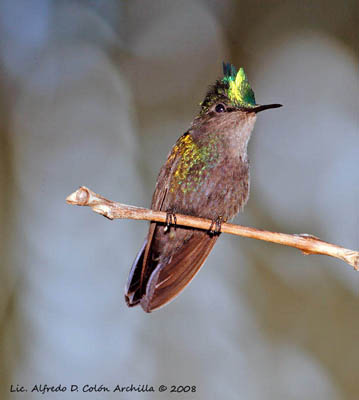
Antillean Crested Hummingbird
Orthorhynchus cristatus
Apodiforme Order – Trochilidae Family
BIOMETRICS:
Length: 8-9,5 cm
Weight: 3,5-4 g
DESCRIPTION:
Antillean Crested Hummingbird is the smallest hummingbird within its geographic range.
Fr: Colibri huppé
All : Antillenhaubenkolibri
Esp : Colibrí Crestado
Ital : Colibrì crestato delle Antille
Nd : Antilliaanse Kuifkolibrie
Photographs by Alfredo Colón
Puerto Rico Wildlife
Text by Nicole Bouglouan
Sources:
HANDBOOK OF THE BIRDS OF THE WORLD Vol 5 by Josep del Hoyo-Andrew Elliott-Jordi Sargatal - Lynx Edicions - ISBN: 8487334253

Adult male has glossy bronze-green upperparts. Flight feathers and tail are darker, rather bluish-black to brownish. Central tail feathers are mostly dark bronze-green.
The underparts are blackish. Breast sides show glossy bronze-green feathers. Underwing and undertail are sooty black.
Head is glossy green on crown and nape, with green frontal crest tipped metallic green to bright blue-green. Chin, throat and cheeks are sooty black.
The black bill is short and straight. Eyes are dark brown. Legs and feet are blackish.
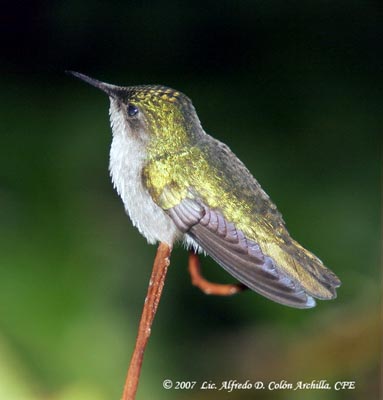
Female is similar on the upperparts, but she has pale grey underparts. She lacks the crest on the crown. Her blackish tail shows broad pale greyish tips on the four outer tail feathers.
Juvenile resembles female, with washed cinnamon head.
Antillean Crested Hummingbird has four subspecies which differ in crest colour and geographic range among the islands.
O.c. cristatus lives in Barbados.
O.c. exilis has green crest with washed blue tips. It is found in Puerto Rico and Lesser Antilles to St Lucia.
O.c. ornatus has terminal part of crest abruptly blue. It lives in St Vincent.
O.c. emigrans is similar to nominate with gloss more bluish-purple and paler underparts. It is found in Grenadines and Grenada.
VOICE: SOUNDS BY XENO-CANTO
Antillean Crested Hummingbird’s common calls are high-pitched chirps and unmelodious whistles. The calls used in defence of the territory or feeding area are series of rapid chattering, as loud vocal signals.
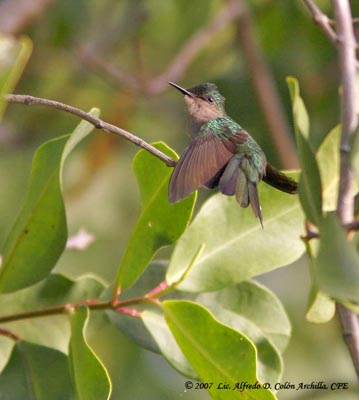
HABITAT:
Antillean Crested Hummingbird is abundant in lowlands, below 500 metres. It is found in open areas, parks and forest edges. But it is also widespread from sea-level to the mountain forests.
RANGE:
Antillean Crested Hummingbird is found in Puerto Rico and in all islands of the Lesser Antilles and surroundings.
BEHAVIOUR:
Antillean Crested Hummingbird feeds primarily on nectar of different flowers’ species. It also collects small arthropods from vegetation or snatched in flight.
It is active at dawn and dusk, visiting flowers and defending its food resources against other hummingbirds’ species. Feeding territory is established at flowering bushes in order to provide its daily energy needs.
It defends this area from high perches situated in nearby vegetation, and gives warning calls, and it also may perform some flights towards intruders.
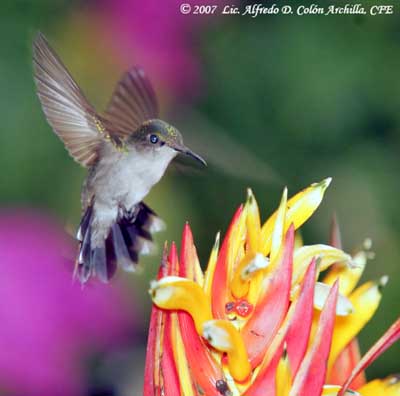
Antillean Crested Hummingbird spends most of its time perched while singing, preening or taking sun.
During the breeding season, male and female remain together only for short period. The male uses the same displays for defence of territory or to attract a female. Male is polygamous and does not take part in nesting duties.
Female selects the nest-site near rich nectar source. She hovers while searching for a suitable branch for the nest.
Antillean Crested Hummingbird is sedentary in its range, with probably some dispersion according to the food resources.
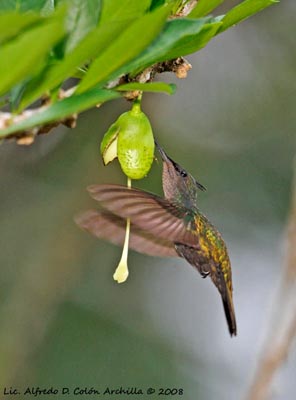
FLIGHT:
As other hummingbirds, the Antillean Crested Hummingbird is able to hover in all directions when feeding on nectar. The bird seems to be motionless, but its wing beat rate is about 70 to 80 per second. The wings move mainly horizontally and form a flat figure of “8” with the tips. The bird is able to fly forwards, backwards, side to side, and also upwards and downwards.
REPRODUCTION:
Antillean Crested Hummingbird breeds all year round, with a peak between March and June.
The female selects the nest-site and builds the nest. It is a small cup situated in a shrub or in vine, on thin branch, at about one to three metres above the ground and among foliage.
This tiny cup is decorated outside with dead leaves, fine chips of bark and lichens. The interior is lined with soft plant fibres.
Female usually lays two eggs. Incubation lasts about 17 to 19 days, by female alone.
Chicks have dark grey down on back at hatching. They are fed by female and they remain at nest 19 to 21 days.
After leaving the nest, young remain for about 3 to 4 weeks more with their mother. They reach their sexual maturity through their second year.
This species produces only one brood per season.
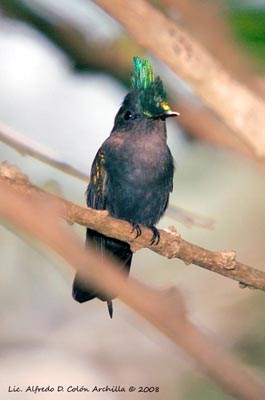
DIET:
Antillean Crested Hummingbird feeds mainly on nectar from several flowering shrubs, vines, hedges and trees. It also consumes small arthropods from vegetation or caught in flight.
PROTECTION/THREATS/ STATUS:
Antillean Crested Hummingbird lives in restricted range, but it is common, especially at sea-level.
This species is not threatened at this moment.